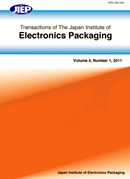10 巻
選択された号の論文の11件中1~11を表示しています
- |<
- <
- 1
- >
- >|
Preface
-
2017 年 10 巻 p. Pref01_1
発行日: 2017年
公開日: 2017/12/25
PDF形式でダウンロード (119K)
Technical Papers
-
2017 年 10 巻 p. E16-017-1-E16-017-6
発行日: 2017年
公開日: 2017/03/24
PDF形式でダウンロード (2531K) -
2017 年 10 巻 p. E16-006-1-E16-006-10
発行日: 2017年
公開日: 2017/03/24
PDF形式でダウンロード (1219K) -
2017 年 10 巻 p. E16-016-1-E16-016-6
発行日: 2017年
公開日: 2017/03/30
PDF形式でダウンロード (1142K) -
2017 年 10 巻 p. E16-012-1-E16-02-10
発行日: 2017年
公開日: 2017/04/19
PDF形式でダウンロード (2745K) -
2017 年 10 巻 p. E16-018-1-E16-018-6
発行日: 2017年
公開日: 2017/07/28
PDF形式でダウンロード (1792K) -
2017 年 10 巻 p. E17-001-1-E17-001-6
発行日: 2017年
公開日: 2017/10/29
PDF形式でダウンロード (1289K) -
2017 年 10 巻 p. E17-009-1-E17-009-10
発行日: 2017年
公開日: 2017/12/25
PDF形式でダウンロード (896K) -
2017 年 10 巻 p. E17-003-1-E17-003-7
発行日: 2017年
公開日: 2017/12/25
PDF形式でダウンロード (716K) -
2017 年 10 巻 p. E17-002-1-E17-002-6
発行日: 2017年
公開日: 2017/12/25
PDF形式でダウンロード (1358K) -
2017 年 10 巻 p. E17-004-1-E17-004-8
発行日: 2017年
公開日: 2017/12/25
PDF形式でダウンロード (578K)
- |<
- <
- 1
- >
- >|
